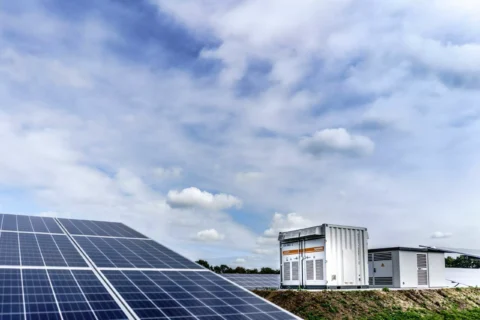Energy storage is critical to enabling on-demand renewable energy
The full potential of renewable energy to fight climate change can only be realized if complemented with long duration energy storage (LDES) technologies. The storage of surplus renewable energy for multiple hours, days, or even weeks to meet on-demand energy requirements significantly reduces the stress on our power systems due to the intermittency of renewable energy.
According to a report by McKinsey, in the US alone, it’s estimated that LDES could reduce the overall cost of achieving a fully decarbonized power system by around USD 35 billion annually. For these reasons, the LDES market is projected to grow 400x by 2040 and will require a total investment of USD 1.5 trillion to 3 trillion.
However, lithium-ion batteries – the most commercialized energy storage technology in the market today – are not suitable for LDES applications due to their storage capacity and cost. Moreover, lithium-ion batteries are composed of rare-earth metals whose mining is environmentally-intensive and exposed to child labor risks.
We need alternative solutions to lithium-ion batteries to store renewable energy as it gains more share in the global energy mix. But how do we identify what are the right LDES technologies to invest in?
Evaluating LDES technologies
There are four kinds of novel LDES technologies: thermal, electrochemical, mechanical, and chemical. These technologies either use different ingredients or different mechanisms, but all allow energy to be stored when there is a surplus and released when there is a shortage.
Ultimately, there is no one-size-fits-all solution and no single technology is going to win the market. We need a portfolio of technologies to meet energy demands in different use cases at grid, industry, building, or residential level. LDES can be a financially attractive option to decrease energy costs and to decarbonize energy consumption, enabling customers to reach environmental, social, and corporate governance targets.
Through our work analyzing exciting innovations for our clients, we’ve evaluated several LDES technologies globally, all at different stages of maturity. Very few have been proven with commercial pilots, while many are still at the lab or small demo phase. In early phases, there remains a lack of clarity as to whether a particular LDES technology can be scaled up for commercial deployment. Many companies have touched high valuations in the range of USD 0.5-2 billion, despite being early in their commercialization journey. Such valuations are mainly driven by high interest from strategic and financial investors.
While there is a significant market potential of LDES, investing in a LDES technology comes with high technology and scale up risks that are further elaborated below.
Technology
The life of LDES technologies tend to be 20-40 years, much longer than lithium-ion batteries that need replacement within 3-5 years. Technologies can use numerous chemistries involving Iron, CO2, Zinc, Vanadium, and molten salts, or different mechanisms using gravity or compressed air. However, even using the same chemistry or mechanism could lead to different round-trip efficiency (the higher the better) and levelized cost of energy storage (the lower the better). Based on our experience, very few companies are able to achieve the highest efficiency and lowest cost together. Instead, it is often a trade-off between the two. If the technology is using a naturally available, abundant material, we believe there is room to compromise on efficiency over cost.
US-based Form Energy, which uses iron rusting for multi-day energy storage, is targeting an extremely low levelized cost of USD 20/kWh which is roughly 10x lower than lithium-ion batteries. Iron is one of the most abundant materials on Earth, thus there is a significant improvement in environmental impact compared to using rare-earth metals. Form Energy recently raised a large round of USD 450 million in series E to start its commercial production in 2024. Soon enough, such large rounds – and underlying valuations – will become commonplace as more LDES technologies evolve from R&D phase to manufacturing and commercialization.
Scalability
There are a range of different aspects to consider when it comes to scalability, including engineering, supply chain of raw materials or equipment, manufacturability, time to market, and the ability to sell the technology to customers. We have seen some technologies that work perfectly well in a lab environment but struggle to launch large commercial prototypes or find the necessary equipment in the market. Often, it requires establishing a new supply chain for equipment or materials which becomes a bottleneck for scalability. As a result, a technology can take years before it is rolled out commercially.
This risk is usually identified at an early stage by smart entrepreneurs who have commercialized hardware technologies in their previous professional lives. This also connects with the sales strategy and ability of the team to identify the product-market fit, depending on the storage duration and charging and discharging cycles. The sales pipeline is driven with the right business model, either as a technology supplier or offering turnkey solutions.
Switzerland-based Energy Vault, which uses gravity to store energy in heavy weights for several hours, built its first demo plant of 35 MWh in 2019 and expects to commission its second commercial plant in 2023. Such a long gap is often seen in many companies. Its technology requires a tall built environment above the ground to move heavy weights, which could restrict the gravity storage potential and make it intensive on capital expenditure.
There are other gravity-based technologies that use existing deep mine shafts 200-500m under the ground, making LDES scalable with lower cost. These don’t require expensive built environments and in most cases, the mines are already connected to the power grid, which accelerates the project timelines. Energy Vault raised USD 100m in series C in 2021 before being listed publicly in February 2022. However, its valuation came with a high risk where its market cap has reduced by roughly 60% to USD 0.5bn (as of 1 Dec 2022).
Overall, LDES technologies must prove themselves in small pilots and show a path forward for commercial feasibility. Costs should ideally be lower than lithium-ion batteries and the materials used should be naturally and abundantly available to remove dependency on rare-earth metals, which is critical to significantly reduce stress on the environment. In addition, identifying a team that has both technical and commercial expertise to build a technology and to effectively sell it to customers will be instrumental in delivering results. With a combination of these factors, LDES technology offers significant potential to not only deliver outstanding financial returns but also significant environmental impact by unlocking 24×7 renewable energy at scale that will be necessary for our global economies to decarbonize.




